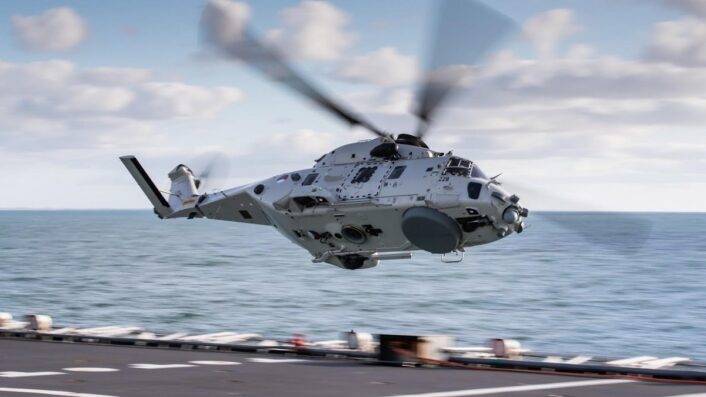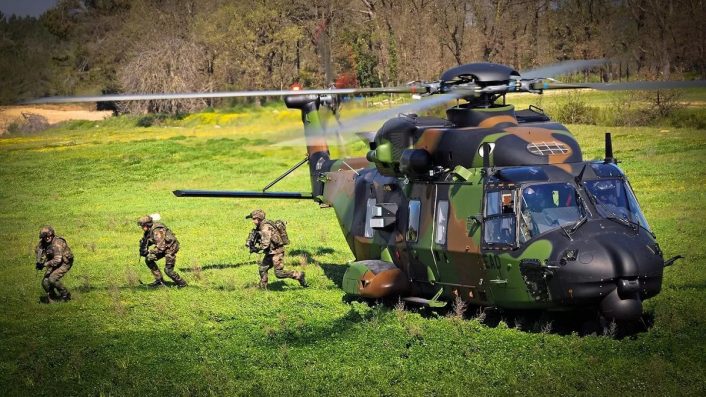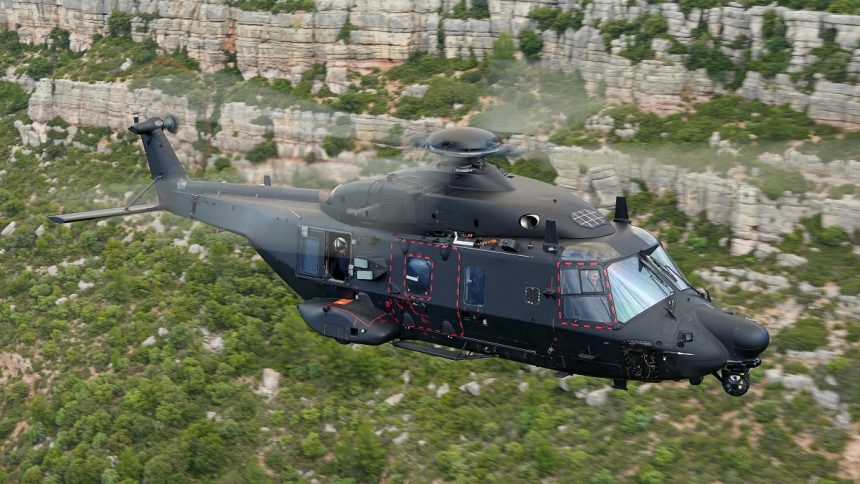The two programs are part of the NH90 evolution roadmap and constitute a major upgrade in terms of capabilities for the European helicopter.
Airbus announced the beginning of the flight test campaign of NH90 Special Operations Forces prototype, currently being developed specifically for the Aviation légère de l’Armée de Terre (French Army Aviation). The news was announced during the recent Eurosatory 2024 exhibition, few days after the signing of the contract for the development of the Block 1 upgrade for all helicopters currently in service.
The NH90 is currently the largest military helicopter programme in Europe. Available in two main variants, one specified for naval operations, the NH90 NFH (NATO Frigate Helicopter), and the TTH (Tactical Transport Helicopter) for land-based operations, the NH90 is manufactured by NHIndustries, which is the largest rotorcraft Joint Venture in European history owned by Airbus Helicopters (62.5%), Leonardo (32%) and GKN Fokker (5.5%).
Overall, around 490 NH90 helicopters, a mixture of both variants, are in service worldwide, although some of its operators decided to terminate operations with the type earlier than planned due to multiple problems. The new upgrades, however, appears to be only for some of the remaining operators.
NH90 Standard 2 for SOF support
The NH90 Standard 2 is being specifically developed for the French Army Aviation to support the needs of the SOF (Special Operations Forces). Airbus reports that the French Ministry for Armed Forces has ordered a total of 18 helicopters in this configuration.
The Standard 2 configuration includes the integration of the Safran Euroflir 410 electro-optical system, a new digital map generator, installation for a third crew member and new enlarged rear sliding windows able to accommodate self-protection guns. It’s not clear however if the countermeasures’ dispensers might impact the crew and the operation of the weapons, given the vicinity of the dispensers to the windows.

Further upgrades are expected down the road, as prototype of the NH90 Standard 2 has also been equipped with mechanical and electrical provisions for the later integration of the Distributed Aperture System (DAS) and a new generation Helmet Mounted Sight Digital Display (HMSD-DD). The latter appears to be the Thales TopOwl Digital Display helmet, as announced in 2021 by the system’s maker.
Airbus says flight testing is scheduled to continue until the end of the year, validating the design of the new configuration which will need to be able to operate in highly demanding conditions. The company hinted that the aircraft will be delivered in a relatively short timeline, mentioning that the French Army Aviation will operate 81 NH90s by the end of the decade, of which 63 TTHs already delivered and the remaining 18 should be the new Standard 2.
The Standard 2 program was launched in 2020 by the NATO Helicopter Management Agency (NAHEMA) and NHIndustries (NHI) and its partner companies, with an initial provision of ten helicopters. In Dec. 2023, NHI received the order for eight additional helicopters, bringing the total to 18.
NH90 Block 1 upgrade for TTH and NFH variants
Few days before the Standard 2 test, NH Industries (NHI) and the NATO Helicopter Management Agency (NAHEMA) have signed a contract to launch the development and qualification of the NH90 Block 1 upgrade. Also known as Software Release 3, this programme is part of the NH90 evolution roadmap and constitutes a major upgrade in terms of capabilities for both the TTH and NFH variants of the NH90 combat helicopter.
“The signature of the SWR3 contract, which marks the launch of the NH90 Block 1 upgrade, is an important milestone for the NH90 programme and is a clear sign that our NATO customers trust the NH90 and plan on operating it for many more decades to come,” said Axel Aloccio, President of NHI and Head of NH90 Programme at Airbus Helicopters. “We have a clear plan to extend the life span of the NH90 up to 50 years and we will need to upgrade the aircraft to make sure it stays relevant on the battlefield of tomorrow.”

It appears that not all the NH90 operators have decided to proceed with the upgrade, as Airbus mentions NAHEMA acted on behalf of Belgium, Germany, the Netherlands, and Italy. However, we cannot exclude a later participation, as even more upgrades are being planned.
“The Block 1 programme will cover the next ten to fifteen years,” added Aloccio. “Beyond that horizon, we are also planning the Block 2 upgrade that will define the future evolutions of the platform and ensure that it continues to meet the needs of the battlefield of tomorrow.”
Airbus mentions the first phase of this 600 million Euro programme includes an upgrade of the NH90 communication suite and the integration of Data Link 22 allowing beyond line-of-sight interoperability without going through satellite communications. IFF Mode 5 Level 2, the latest version of the device used to identify and track military aircraft and often described as an encrypted ADS-B, will also be integrated.
Other upgrades will be available to the operators and include the integration of an unspecified latest generation electro optical system, a new dipping sonar and the integration of the MK 54 torpedo and the Marte ER anti-ship missile, with the latter two being specific to the NFH variant, given their nature. The NH90 Block 1 will be able to navigate with a civil grade global navigation satellite system (GNSS) and flight management system.
The press release adds that the second phase of the programme, which is currently under finalisation, will consist of the deployment of the Block 1 configuration improvements on approximately 200 NH90s, both NFH and TTH, in total. It appears that not all the helicopters in service with Belgium, Germany, the Netherlands, and Italy, as the total number of NH90 in their fleets is approximatively of 240 aircraft.
Mixed results internationally
More than 500 NH90 helicopters have been sold to 14 countries. Despite its commercial success the program has also had some setbacks, mainly due to certification holdups and technical difficulties that slowed the international program especially at the beginning.
However, not all its operators are fully satisfied and some of them already decided to retire the European helicopter. At the end of 2021, the Australian Defence Force announced that it would retire its entire fleet of MRH90 Taipan helicopters a decade earlier than scheduled. In June 2022, the Norwegian government decided to immediately halt all operations with the NH90 helicopters and to terminate the contract mentioning “delays, errors and time-consuming maintenance” as the cause of the abrupt decision to put an end to the programme after 20 years.
On the other hand, some other operators like the Italian Army and Navy are not encountering any particular problem with their helicopters and are looking forward to employing the type for the years to come. Some other operators, like France and Spain, are even buying new NH90 to increase their fleets.









